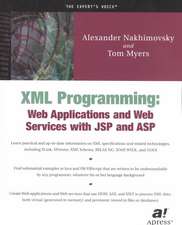Google, Amazon, and Beyond: Creating and Consuming Web Services
Autor Alexander Nakhimovsky, Tom Myersen Limba Engleză Paperback – 4 dec 2003
Preț: 267.62 lei
Preț vechi: 334.53 lei
-20% Nou
Puncte Express: 401
Preț estimativ în valută:
51.22€ • 53.27$ • 42.86£
51.22€ • 53.27$ • 42.86£
Carte disponibilă
Livrare economică 22 februarie-08 martie
Preluare comenzi: 021 569.72.76
Specificații
ISBN-13: 9781590591314
ISBN-10: 1590591313
Pagini: 348
Ilustrații: XXI, 352 p. 54 illus.
Dimensiuni: 191 x 235 x 18 mm
Greutate: 0.65 kg
Ediția:Softcover reprint of the original 1st ed.
Editura: Apress
Colecția Apress
Locul publicării:Berkeley, CA, United States
ISBN-10: 1590591313
Pagini: 348
Ilustrații: XXI, 352 p. 54 illus.
Dimensiuni: 191 x 235 x 18 mm
Greutate: 0.65 kg
Ediția:Softcover reprint of the original 1st ed.
Editura: Apress
Colecția Apress
Locul publicării:Berkeley, CA, United States
Public țintă
Professional/practitionerCuprins
1 Defining Web Services.- 2 The Plumbing: DOM and SOAP.- 3 More Services: Java Applet.- 4 DBService and a Book Club.- 5 Authentication and REST.- 6 Restructuring Results with XSLT.- 7 Tomcat, JSP, and WebDAV.- 8 WebDAV Client to Database via XML.- 9 WSDL and Axis.- Appendix A Installation.- Appendix B Troubleshooting.- Appendix C Online Resources.- Standards.- W3C Technical Reports.- OASIS Technical Committees.- Other Consortia.- Sources of Information.- XML Resources.- Java XML Processing and Web Services.- Web Services.- Keep Looking.
Recenzii
From the reviews:
"In contrast to a great many other books on web services, this book is structured firmly around what is out there and what works. … A number of extended examples are used in the book … . This extended example brings together many of the topics that are covered separately. … the book also provides much useful additional, but essential, material. … Overall then, this is a useful book … . the reader can very quickly get up to speed and start experimenting." (TechBook – Report – online, March, 2004)
"In contrast to a great many other books on web services, this book is structured firmly around what is out there and what works. … A number of extended examples are used in the book … . This extended example brings together many of the topics that are covered separately. … the book also provides much useful additional, but essential, material. … Overall then, this is a useful book … . the reader can very quickly get up to speed and start experimenting." (TechBook – Report – online, March, 2004)
Notă biografică
Alexander Nakhimovsky received a master's degree in mathematics from Leningrad University in St. Petersburg�and a Ph.D. in linguistics from Cornell University, with a graduate minor in computer science. He has been teaching computer science at Colgate University since 1985. He is the author (jointly with Tom Myers) of several books and book chapters, including JavaScript Objects, Professional Java XML Programming, and Professional Java Server Programming, J2EE Edition, as well as books and articles on linguistics and artificial intelligence.
Caracteristici
Presents Web service interfaces to Google, Amazon, and others Describes, with many examples, how to create Web service clients in cross-browser Javascript, Java (including JSP) and .NET in a hands-on approach Shows how to build Web services which combine the results from existing services with your own programs and database usage; shows how RSS and other XML data can supplement web services
















